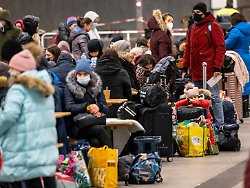UNHCR figures
Where most of the Ukraine refugees arrive
Laura Stresing
03/29/2022, 4:37 p.m
The war in Ukraine is triggering a humanitarian crisis: more than 3.8 million people have already fled the fighting, mostly to neighboring countries. UNHCR figures show which countries have received the most refugees.
On February 24, 2022, Russia launched an attack on Ukraine. Since then, according to estimates by the United Nations refugee agency UNHCR, more than 3.8 million people – mainly from eastern Ukraine – have left their homeland to seek protection abroad. Between February 21 and 23, around 113,000 people are said to have left the Donetsk and Luhansk regions, some of which were occupied by the separatists, for Russia even before the fighting began.
The graphics from ntv.de show how the flow of refugees has developed over time and which countries have received the most people seeking protection. UNHCR compiles the figures from various sources and publish them on a special page. Some of the information is an estimate. The EU Commission expects a total of up to seven million displaced persons as a result of the war.
The countries immediately neighboring Ukraine have recorded the largest influx of refugees, especially Poland. More than half of the refugees were initially taken in there. Several hundred thousand victims have also made their way to Moldova and from there to Romania. Due to the multiple border crossings, the sum of those arriving in the most important (first) reception countries exceeds the total number of refugees given by the UNHCR – the refugee agency tries to avoid double counting as far as possible.
After arriving in neighboring countries, many of the Ukrainian war refugees travel on to other European countries. On March 25, the EU Commission presented a “ten-point plan” for better distribution and coordination of the flow of refugees. Among other things, there should be a “distribution index” to increase the pressure on the member countries that have so far taken in only a few refugees compared to their total population and economic power.
So far, more than 278,000 Ukrainian refugees have arrived in Germany (as of March 29). At least that is the official number published by the Federal Ministry of the Interior and determined by the Federal Police on the basis of increased controls, for example at border crossings, at train stations and on trains. Since the refugees can move freely after their arrival in the EU and there is still no uniform registration procedure, it can be assumed that there is a significant under-recording.
